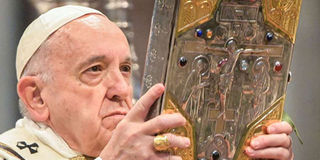The arduous process of becoming a Roman Catholic Church saint

Pope Francis. The canonisation on Sunday of Britain's Cardinal John Henry Newman – one of the Roman Catholic Church's most renowned converts – and four others is the last stage in the Vatican's arduous process of creating saints. PHOTO | VINCENZO PINTO | AFP
What you need to know:
- The Church puts candidates through meticulous vetting and in most cases two "miracles" are required.
- Once the candidate's holy reputation is recognised, he or she becomes a "Servant of God".
- If Vatican investigators recognise a "miracle", the candidate is "beatified", and referred to as "blessed".
Vatican City
The canonisation on Sunday of Britain's Cardinal John Henry Newman – one of the Roman Catholic Church's most renowned converts – and four others is the last stage in the Vatican's arduous process of creating saints.
The Church puts candidates through meticulous vetting and in most cases two "miracles" are required, usually healings resulting from the candidate's posthumous intercession in answer to prayers.
Friends or relatives can apply posthumously for their loved one to be recognised as having a "reputation for sainthood", which gets the ball rolling on the full sainthood application process.
CROWD FAVOURITES
This usually begins at least five years after a person's death, although this was not the case for crowd favourites Mother Teresa and pope John Paul II for whom the timetable was shortened.
Once the candidate's holy reputation is recognised, he or she becomes a "Servant of God". A "postulator" is appointed to collect testimonies and compile all of the candidate's writings, producing a warts-and-all curriculum vitae.
The file then goes to the Vatican's Congregation for the Causes of Saints department, where it is submitted to severe scrutiny by an official known today as the Promoter of Justice – formerly the Devil's Advocate.
VENERABLE
If the Vatican gives the go-ahead, the candidate is henceforth considered "Venerable".
The search begins for an inexplicable healing attributed to the candidate, who is considered to have interceded with God on behalf of the sick to bring about the "miracle".
Doctors and theologians are involved in in-depth investigations of such supposed miracles, and many candidates are rejected at this stage because scientific explanations cannot be ruled out.
BLESSED
If Vatican investigators recognise a "miracle", the candidate is "beatified", and referred to as "blessed".
Many years can pass between the attribution of a first and a second miracle and some sainthood candidates never move beyond the "blessed" stage.
If a second miracle is recognised, however, the candidate can qualify for canonisation, becoming a saint.
In the case of "Good Pope" John XXIII, who launched the Vatican II reform drive in 1962, Pope Francis waived this requirement with the consent of the College of Cardinals.
EXPENSIVE
The process can be very expensive – costing up to USD1 million (900,000 euros) – and this has tended to favour candidates from the developed world.
Italy boasts some 260 saints, while only a dozen have hailed from Africa.
Francis has however changed the rules to make the process less costly.
OTHER PATHWAYS
Other pathways to sainthood include martyrdom, with dying for one's faith warranting beatification, although a miracle is still required to attain sainthood.
Another means, known as "equivalent canonisation", recognises a candidate who has long been venerated as a saint in his or her local region.
Pope Francis has created several saints on this basis.
In July 2017 the pontiff added a new pathway to becoming a saint for Christians who lay down their lives to save others.





